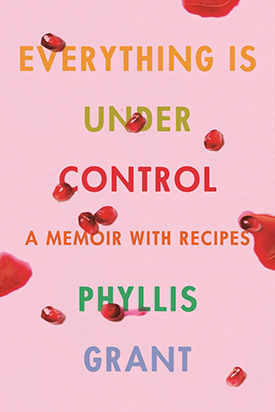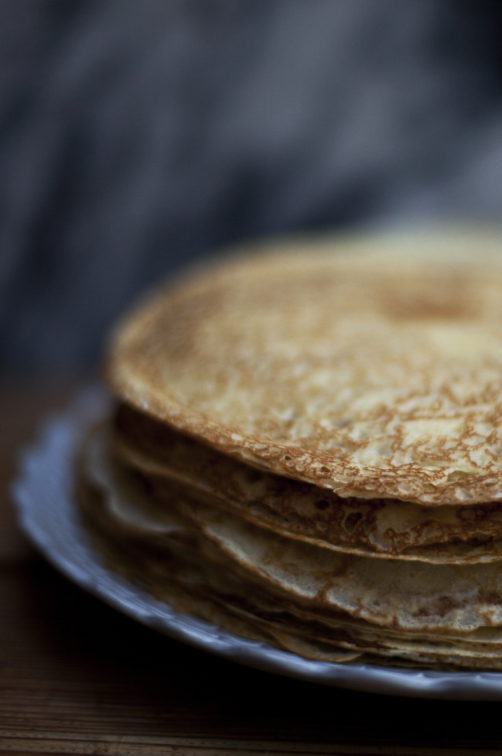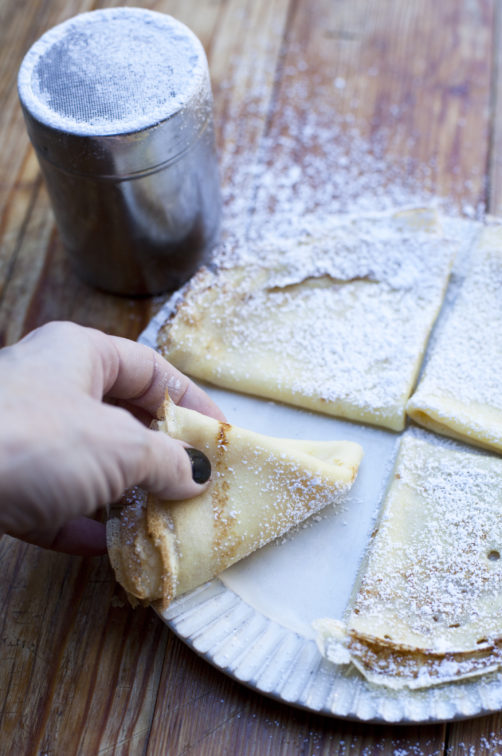
Phyllis Grant’s Everything Is Under Control (out April 2020) is a memoir about appetite—how it comes, goes, and refocuses its object of desire. Grant’s story spans her days as a dancer struggling to find her place at Juilliard, her time in and out of four-star kitchens in New York City, her love story with her future husband, and her experience of leaving the city after 9/11 for California where her children are born. Everything Is Under Control is written as a series of raw vignettes followed by tried-and-true recipes from Grant’s table. As Grant says, the book is “240 pages of stories and recipes written in notebooks at restaurants, on my phone in the carpool pickup line, on cocktail napkins at bars, in my head at playgrounds, and sitting on my dirty kitchen floor in the middle of the night.” The following story and crêpe recipe have never been published before, and like those in the book, show the interwoven nature of Grant’s life inside and outside of the kitchen.
Cloudy head. Cloudy heart. Billowing sadness from outside in, inside out. All of my organs are jumbled, pushed aside after my second pregnancy, peripherally lodged in my torso. I lie on my back, my hands on my belly, and try to breathe life back into my enervated core.
It hurts to walk up stairs, to roll over in bed, to pick up my screaming son. I wake up one morning to see my guts poking out of the split in my rectus abdominis. A doctor friend tells me to drink a few shots of tequila and then push the insides back in. It’s nice to know I am not empty in the middle.
Just gathering the diaper bag paraphernalia feels insurmountable. By the time I enter the park with my son, I want to go home. I force myself to sit and watch the children play. Dads and moms and nannies yammer at me about first steps, first foods, first smiles. I heavily caffeinate to manage, yawning through their stories with my mouth closed, causing tears to drip down behind my sunglasses. I stop going.
I become a master organizer of 1T and 2T and 3T shirts, whole grains, baking spices, and board books. All labeled and ready for the time I will feel some ease. Like pickling and canning for Armageddon, I set myself up for when the love will come, preparing for the morning I will wake up and say today, let’s make muffins and take a walk to the park. I know the sadness will pass. It did four years before with my daughter. All I can do is wait.

While I wait, others worry. Get help, they say. Take care of yourself. So I hire a series of CPR-trained goddesses to whom I hand off my son a few hours a week. I drive towards the grocery store and end up at the mall buying another beige sweater that looks like a bathrobe. I head for the café to re-read Ferber’s sleep training book and end up circling around the neighborhood without ever parking.
And then I hire Anne. She is from France and living in Berkeley for the year while her husband works attophysics magic at Lawrence Berkeley National Laboratory. Thanks to Anne, my son’s first big words are in French: l’arbre and je t’aime and les saucisssons. Meals are a thing, not an event to be rushed through or eaten in the stroller. They sit down on the back porch—Anne in her sun hat; my son on his knees, unstrapped in his highchair, three-point-harness be damned—sharing tomato tartines and chunks of old Manchego. No cheese is too moldy for Anne.
She talks to him as if he’s a friend, not a toddler. I watch them putter around the kitchen: slicing apples, smearing Nutella, flipping crêpes. I ask for her crêpe recipe. She tells me there is no recipe, that she just does what her mom and grandmother did. The more butter you add to the batter, the less you need in the pan. That you need to add enough milk until it looks right. And then add just enough flour. I don’t know what this means. But I stop driving in circles. I stop buying sweaters. She makes me want to stay home.
• • •
CRÊPES
Anne left me a piece of paper with the ingredients needed. The details came after years of trial and error.
I use a traditional French 9-inch crêpe pan (yields 7-inch crêpes). You can use an equivalent-sized (or larger) nonstick pan. If you use a larger pan, just be sure to pour the batter into the center first, then swirl slowly to form about a 7-inch round.
As a rule, the first one is a mess up, so give it to the dog. The second one is for the cook to eat. And the third one goes to the first kid at the table.
Makes 6 cups of batter, enough for about 32 seven-inch crêpes
(3 tablespoons batter per crêpe)
ingredients:
1 stick (8 tablespoons) unsalted butter (6 tablespoons for the batter, 2 tablespoons for cooking)
2 cups all-purpose flour
3 ½ cups whole milk
4 large eggs
1 tablespoon sugar
¾ teaspoon kosher salt
directions:
Melt 6 tablespoons of the butter on medium heat. Cool for 20 minutes, or until room temperature.
Measure out your flour. Pour your measured milk into a pitcher.
In a large bowl, whisk the eggs, sugar, and salt until smooth. To the eggs, add about ½ cup milk and a ¼ cup of the flour (no need to be precise here). Whisk until the flour clumps are mostly gone. Working in batches, whisk vigorously between additions until lumps have mostly disappeared. Continue until all milk and flour have been incorporated (about seven rounds).
Whisking the whole time, slowly drizzle a large spoonful of the egg-flour-milk mixture into the cooled melted butter. Repeat with another spoonful. Then whisk the butter mixture into the egg-flour-milk mixture. It should be about the thickness of warm maple syrup. If it’s too thick, add some more milk. If it’s too runny, sift over some more flour. Cover. Set aside for a few hours or refrigerate overnight. Make sure you take the crêpe batter out of the fridge at least 30 minutes before cooking. I usually leave the batter out overnight so that it’s ready to go first thing but only do this if you live in a cool climate.

When you’re ready to cook the crêpes, melt remaining 2 tablespoons butter in a small pot. Whisk the batter back together if it has separated. Heat a 9-inch crêpe pan (or nonstick pan) over medium heat. With a pastry brush, lightly coat the bottom of the pan (and a little bit up the edges) with melted butter. After making a few batches of crêpes, you will know how much batter to add and you can just pour the batter directly into the pan from a pitcher. But until you’re clear on the amount, you can be more precise by scooping a scant ¼ cup of batter into a measuring cup. Pour the batter into the center of the hot pan. Tilt and swirl the batter around until you’ve covered the bottom of the pan (as if you’re drawing progressively larger concentric circles). The crêpes cook very fast (30 to 60 seconds). Use a plastic heatproof spatula (you don’t want to scrape your pan) to peek. It’s ready when it’s just getting a speckling of light brown. Tuck the spatula underneath the crêpe and quickly flip it over. Cook until the second side is also speckled brown (about 10 to 15 seconds). Slide crêpe onto a large plate. As you cook them, stack them one on top of the next. No need to put anything in between them. They will not stick together.
Have a pot holder nearby just in case the handle gets too hot. You will have to keep regulating the heat up and down. You should add another light coating of butter every eighth crêpe or so.
Serve them right away all piled up and beautiful.
Or keep them covered in the fridge and reheat them one at a time in a hot pan as needed. Store any extra batter in the fridge for a few days.
You can roll them up. You can fold them in half and then in half again into triangles. You can fill them up with all kinds of things like Nutella, lemon juice and sugar, or ham and cheese. And one more thing: you can make a crêpe cake by piping or spreading a small amount of Nutella in between each of the 32 crêpes (it helps if they are warm). Finish it off with powdered sugar and slice it like the cake that it is.
• • •
Phyllis Grant is an IACP finalist for Personal Essays/Memoir Writing and a three-time Saveur Blog Awards finalist for her blog, Dash and Bella. She has cooked in world-renowned restaurants, including Nobu, Michael’s, and Bouley. Her essays and recipes have been published in a dozen anthologies and cookbooks, including Best Food Writing in both 2015 and 2016. Her writing has been featured in O, The Oprah Magazine, The New York Times, Saveur, The Huffington Post, Time, San Francisco Chronicle, and Salon. She lives in Berkeley, California, with her husband and two children. Follow her @dashandbella on Instagram and Twitter.
